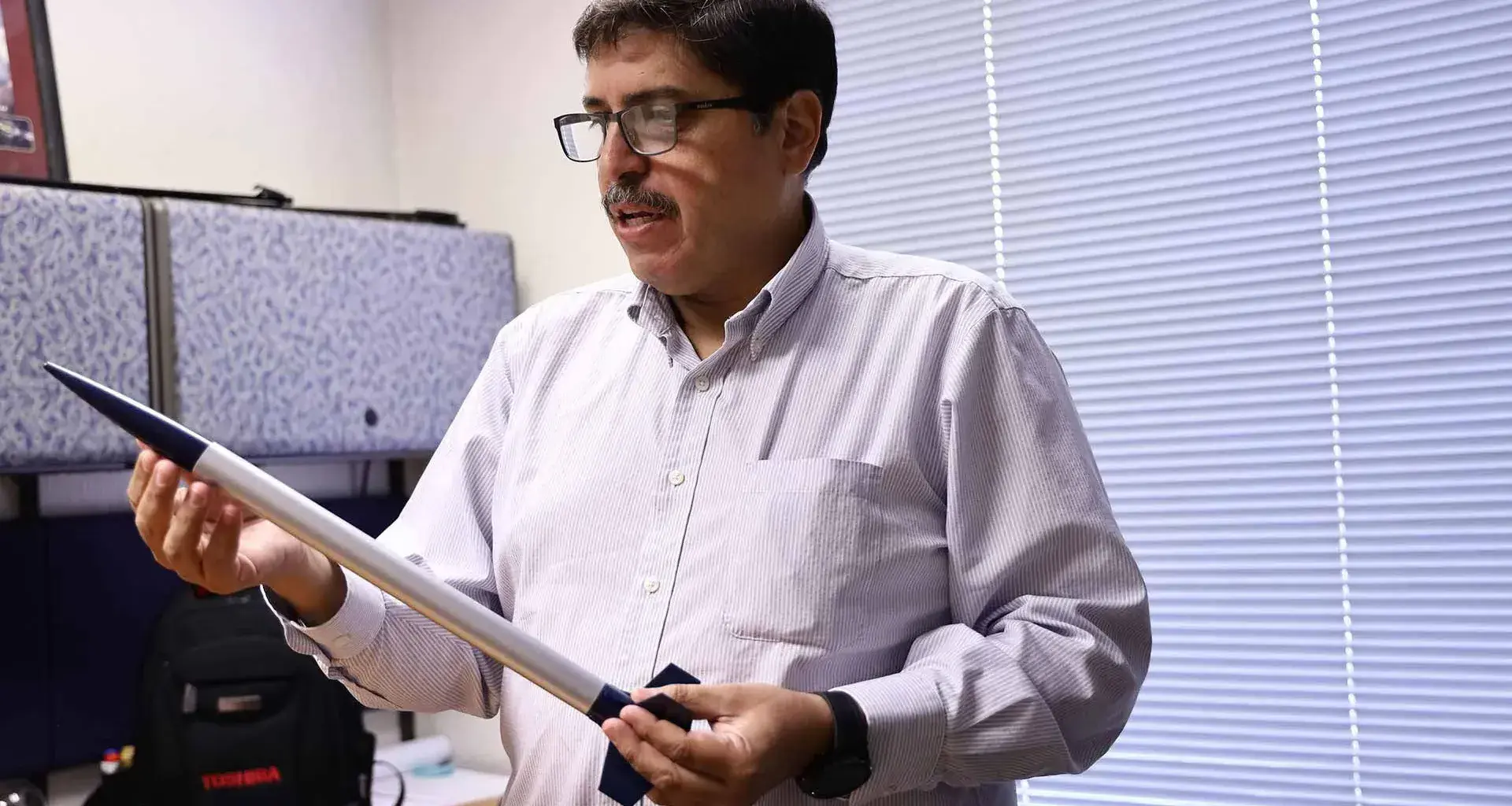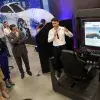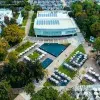Salvador Cortés’s imagination was fired up when he saw Star Wars for the first time. Its lightsabers, spaceships, and mystical creatures gave him a taste of a unique fantasy: the possibility of going into outer space.
He discovered that space exploration was real by closely examining the stamps his father collected, each one adorned with images of satellites, planets, and astronauts.
Convinced that he could apply his talent and passion for computing to space projects, Cortés was able to steer a course through the aerospace industry thanks to his self-taught and entrepreneurial attitude.
Years later, Salvador Cortés and partners set up Arrow Global Solutions, a company dedicated to developing software for the medical and aerospace industries, which has enabled him to work as a supplier on projects with NASA and SpaceX.
Also a physics teacher at PrepaTec Guadalajara, he is determined to share the importance of innovation and scientific development with his students.

Finding inspiration at home
However, Salvador said there were moments when he had to take a different tack. These were times when he had to decide to explore new areas, which became opportunities for personal and professional growth.
“I always wanted to follow in my mom’s footsteps. She worked at IBM and used to tell me about the technology they were developing at the plant. Listening to her sparked my interest in computing,” he remarked.
“My mom was the first computer teacher in Mexico,” he said, mentioning that her inspiration and passion for technology led to him enrolling at a computer institute together with a friend and his brother.
“I remember realizing I could create whatever I wanted the first time I wrote a program. In that moment, I recognized what I was capable of and how far I could go in computing,” he added.
Salvador Cortés started studying Computer Engineering with a clear goal from the first semester: joining the same company where his mother had made her mark.

Defying the limits of what was possible
While he was still studying his final semesters at college, Cortés discovered the opportunity to start working at multinational technology company IBM, thanks to a pre-scholarship program.
He stressed that “applying for the pre-scholarship was an important step. When I saw my name on the shortlist, I felt my heart jump with excitement.”
Cortés said that he was one of the first people to work at IBM Guadalajara’s programming lab, the first of its kind, where they developed technology and documented processes.
“When I started at IBM, I was working in an area that developed technology for restoring defective products, especially hard disk sliders, which are the parts that read the disk,” he explained.
“Each slider had its own aerodynamics; it had to ‘fly’ high enough not to scratch the disk but not so high that it left the magnetic field; we’d return them to the appropriate range by making cuts with lasers,” he explained.
“I was on the docking program for going to the International Space Station. I had to practice for hours with a joystick.”
Innovating to improve processes
After that, the physics teacher shifted tack from the delicate work of sliders to the exciting world of creating technology for space exploration, applying his knowledge to defy the limits of what was possible.
“When I was at IBM, we were given a tour of NASA. Back then, they were working on fabricating a prototype of an escape pod for getting people down from the International Space Station (ISS) in the event of an emergency,” he recalled.
He said that “they told us it was taking them over a week to make the prototype.” In that instant, Salvador Cortés had a brainwave: applying IBM’s laser techniques to optimize and streamline the prototyping process.
“We started working on the development of what was the start of 3D printers. In those days, we’d remove pieces from a polymer block with lasers; today, printers add material to create shapes,” he explained. Thanks to that suggestion, Cortés switched career paths at IBM to work on developing software for the aerospace area.
However, it wasn’t all plain sailing. Their prospects were bleak: “we had a lot of projects on the drawing board, but they were scrapped because of what was happening at the time. The United States government slashed the budget and our projects were abandoned,” he shared.

Houston, I want to be an astronaut...
Despite all the obstacles, Salvador Cortés’s dream of contributing to the aerospace industry was kept alive when he was offered a position on the astronaut training program at NASA.
“I was on the docking program for going to the International Space Station. I had to practice for hours with a joystick to understand how the controls would move,” he explained.
He also shared how they tested the shuttle landing gear on a similar plane: “we’d simulate the conditions to see how the landing would feel,” he said.
However, he faced difficulties once again during his time on the program. “I’d wake up at 5 a.m. just to practice because they wouldn’t give me a chance otherwise,” he said.
"I understood I had to do something, create something that was mine, and use my knowledge to strike out on my own.”
Turning loss into entrepreneurship and growth
After returning to IBM in search of a new challenge, the physics teacher entered the retail industry. As he explained it, “retail refers to the economic sector dedicated to the direct sale of products or services to the end consumer.”
Shortly after he’d started working in the area, IBM sold the division to Toshiba, which led to Salvador Cortés parting ways with the company that he’d seen grow and had helped him fulfill his dreams.
“It was a difficult moment because I’d always seen myself working at IBM; it was the company of my dreams. I never imagined that I’d join Toshiba,” he said.
He said that “I felt I didn’t belong anywhere. I understood I had to do something, create something that was mine, and use my knowledge to strike out on my own in the same industry without depending on an organization.”

Science and technological innovation
That was when Salvador Cortés brought several colleagues together to found Arrow Global Solutions, a company focused on developing software for the medical, aerospace, and environmental sensor industries.
“Through the Internet of Things (IoT), we can collect information that enables us to monitor what’s happening in real time. These data allow us to react and make the necessary adjustments,” explained the teacher.
To this end, Arrow Global Solutions drives innovation and scientific development through projects such as:
- Sensors that help regulate amounts of fuel and monitor temperatures
- Using sensors to monitor the reactions of the human body under extreme conditions
- Technology systems for the medical area
Based on these characteristics and services, Arrow Global Solutions has been able to collaborate with organizations such as NASA, SpaceX, the European Space Agency (ESA), and Open Cosmos.
“Although it’s a really exciting moment, it also makes you anxious about the responsibility of knowing that your software is in space.”
Space technology
“I recall having said that I’d go back to working with NASA someday,” said the academic, who persevered in his dream to collaborate with the big space agencies through his startup.
He mentioned that he’s had the opportunity to develop software which has been fundamental to past space missions, including SpaceX’s Raptor and Merlin engines, as well as the ESA’s Orion capsule.
Cortés also said that he collaborated on implementing a control system for the Europa Clipper mission, which launched at the end of 2024.
“The mission consists of two stages. First, it will attempt to orbit Europa (one of Jupiter’s moons whose surface is covered in ice). Then, it will collect samples of that ice to analyze whether it contains microorganisms,” he explained.
He has also been present at some launches: “although it’s a really exciting moment, it also makes you anxious about the responsibility of knowing that your software is in space,” he remarked.

A future full of possibilities
Finally, Salvador Cortés shared with CONECTA that he has been teaching at PrepaTec Guadalajara for over five years.
He said that, for him, teaching is not only a way to give back to the mentors who inspired him but also an opportunity to make an impact on his students’ growth and future.
“Since I was a young man, I’ve always had a clear vision of technology; I understood that you could do anything with software. It inspires me to think of a future full of possibilities,” said the physics teacher.
That’s why Cortés sees education as a key element in the advancement of science and technology, sharing that the students of today will be the great minds of tomorrow.
“I want to share my experience because learning to share knowledge is what will really make a difference,” he concluded.
ALSO READ:





